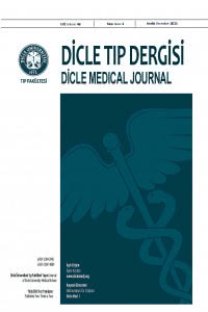Flexible endoscopic procedure in children with foreign bodies in their upper gastrointestinal system
Çocuk, fleksibl endoskop, gastrointestinal sistem, yabancı cisim
Flexible endoscopic procedure in children with foreign bodies in their upper gastrointestinal system
Flexible endoscopy, gastrointestinal system, foreign body, children,
___
- Wright CC, Closson FT. Updates in pediatric gastrointestinal foreign bodies. Pediatr Clin North Am 2013;60:1221-1239.
- Uyemura MC. Foreign body ingestion in children. Am Fam Physician 2005;72:287-291.
- Gregori D, Scarinzi C, Morra B, et al; ESFBI Study Group. Ingested foreign bodies causing complications and requir- ing hospitalization in European children: results from the ESFBI study. Pediatr Int 2010;52:26-32.
- Fox VL. Gastrointestinal Endoscopy. In: Walker WA, Goulet O, Kleinman RE, Sherman PM, Shneider BL, Sanderson IR, eds. Pediatric Gastrointestinal Disease. 4th edn. Ontario: BC Decker, 2004:1691-1692.
- Sandoval JA. Pediatric Gastrointestinal Foreign Bodies. Updated: May 11, 2011 http://emedicine.medscape.com/ article/933015-overview#showall
- Antoniou D, Christopoulos-Geroulanos G. Management of foreign body ingestion and food bolus impaction in chil- dren: a retrospective analysis of 675 cases. Turk J Pediatr 2011;53:381-387.
- Kay M, Wyllie R. Pediatric foreign bodies and their manage- ment. Curr Gastroenterol Rep 2005;7:212-218.
- İnci İ, Özçelik C, Ülkü R, Eren N. Özofagus Yabancı Cisim- leri: 682 Olgunun İncelenmesi. GKDC Dergisi 1999;7:148- 152.
- Alpay HC, Kaygusuz İ, Karlıdağ T, et al. Özefagus Yabancı Cisimleri. Fırat Tıp Dergisi 2008;13:247-250.
- Sayır F. Özofagus Yabancı Cisimleri: 329 Olgunun Analizi. The Eurasian Journal of Medicine 2007;39:112-114.
- Çobanoğlu U, Can M. 0-7 Yaş Dönemi Çocuklarda Özo- fagus Yabancı Cisimleri. Van Tıp Dergisi 2008;15:51-57.
- Köseoğlu B, Bakan V, Bilici S, et al. Çocukluk Çağı Gast- rointestinal Yabancı Cisimlerinin Tedavisi. Van Tıp Dergisi 2001;8:47-53.
- Katsinelos P, Kountouras J, Paroutoglou G, et al. Endoscop- ic techniques and management of foreign body ingestion and food bolus impaction in the upper gastrointestinal tract: a retrospective analysis of 139 cases. J Clin Gastroenterol 2006;40:784-789.
- Tokar B, Cevik AA, Ilhan H. Ingested gastrointestinal for- eign bodies: predisposing factors for complications in chil- dren having surgical or endoscopic removal. Pediatr Surg Int 2007;23:135-139.
- Morgenthal CB, Richards WO, Dunkin BJ, et al. The role of the surgeon in the evolution of flexible endoscopy. Surg Endosc 2007;21:838-853.
- Zhang S, Cui Y, Gong X, et al. Endoscopic management of foreign bodies in the upper gastrointestinal tract in South China: a retrospective study of 561 cases. Dig Dis Sci 2010;55:1305-1312.
- Smith MT, Wong RK. Foreign bodies. Gastrointest Endosc Clin N Am 2007;17:361-382.
- Lee JH, Lee JS, Kim MJ, Choe YH. Initial location de- termines spontaneous passage of foreign bodies from the gastrointestinal tract in children. Pediatr Emerg Care 2011;27:284-289.
- Opasanon S, Akaraviputh T, Methasate A, et al. Endoscopic management of foreign body in the upper gastrointestinal tract: a tertiary care center experience. J Med Assoc Thai 2009;92:17-21.
- Gershman G, Ament M. Practical Pediatric Gastrointes- tinal Endoscopy. Massachusetts: Blackwell Publishing, 2007:105-109.
- ISSN: 1300-2945
- Yayın Aralığı: 4
- Başlangıç: 1963
- Yayıncı: Cahfer GÜLOĞLU
Kemik metastazlarının iskelet sistemindeki bölgesel dağılımı
Füsun AYDOĞAN, Ebuzer KALENDER, Murat RIFAİOĞLU, Recep DOKUYUCU
ÖZHAN ÖZGÜR, Şeyda GÜNDÜZ, Metin ERKILIÇ, Hakan Şat BOZCUK
Merve Yazıcı KARA, Sanem Çakar TURHAN, Ali Abbas YILMAZ, Mehmet ORAL
Flexible endoscopic procedure in children with foreign bodies in their upper gastrointestinal system
Kaan DEMİRÖREN, Ahmet Cumhur DÜLGER, Şehmus ÖLMEZ, Veli AVCI, Salim BİLİCİ, Mehmet MELEK, Halit PULAT
Transrektal prostat iğne biyopsisi sonrası gelişen üriner sistem infeksiyonları deneyimlerimiz
Gülay DEDE, İrfan ŞENCAN, ONUR DEDE, Gönül ŞENTÜRK, Aslı HAYKIR
Milking yöntemi sonrası persistan ektopik gebelik: Olgu sunumu
Semra KAYATAŞ, Didar KURT, MUSTAFA EROĞLU, Sevcan Arzu ARINKAN, Murat APİ
Neurourological complications in patients with myelodisplasia
Sümeyye Çoruh KAPLAN, Cüneyt GÖÇMEZ, Mansur DAĞGÜLLİ
Çocuklarda başlangıç perkütan nefrolitotomi deneyimimiz
Mehmet Hanifi OKUR, Mehmet Şerif ARSLAN, BAHATTİN AYDOĞDU, SERKAN ARSLAN, İBRAHİM UYGUN, ABDURRAHMAN ÖNEN, Selçuk OTÇU
A case of a scrotal mesenteric cyst
Mehmet Nuri BODAKÇI, Namık Kemal HATİPOĞLU, Uğur FIRAT, Necmettin PENBEGÜL, Murat ATAR
Evaluation of protein and lipid oxidative stress in the patients with postmenopausal osteoporosis
